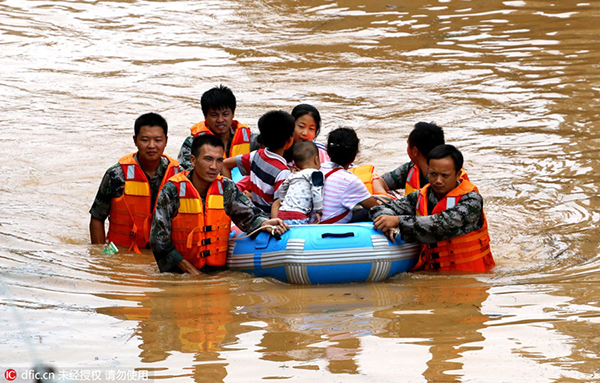High time to reduce costs of floods
Updated: 2016-07-27 07:54
By Dan Steinbock(China Daily)
|
|||||||||
 |
|
Armed police rescue residents in Xiaxi village, Yutian town in South China's Jiangxi province on July 18, 2016.[Photo/IC] |
Weeks of torrential rain have caused a series of devastating floods in many parts of China. With economic losses soaring, the impact will be felt on GDP growth. The estimated loss of more than $44.7 billion makes this year's floods in China one of the costliest non-US weather disaster on record. Only the 1998 floods, which caused a loss of about $40 billion (at 2016 dollar rate), were the same damaging.
Economic growth is very sensitive to adverse impacts on roads, railways and supply disruptions, which can result in shortages. As transport infrastructure is paralyzed or impaired, factories close their doors in industrial provinces, along with offices in post-industrial cities.
Fruit and vegetable prices usually rise in flood-affected areas, where the government now closely monitors prices and implements price controls, if needed. In June, the consumer price index grew 1.9 percent year-on-year. Pork prices played a major role in annualized price increases, adding some 0.7 percentage points to the headline figure. This is not surprising as the seven provinces worst hit by the floods account for more than one-fourth of all hogs in China.
Flooding patterns reflect monsoon seasons. Heavy rains in China occur along the seasonal meiyu ("plum rains") front that extends from East China to the Pacific south of Japan. Associated with the southwest monsoon, these rains typically affect southeastern China from mid-May to mid-June and northern China during July and August.
Severe floods tend to have a substantial impact on agricultural output, which is reflected by the CPI, because of heavy food weightings in the inflation basket. Analysts anticipate flooding to raise consumer prices in July and August by 0.2 percentage points, which would cause price levels to exceed 2 percent.
Rainfalls are particularly heavy in the summer following an El-Niño event, as in 1998 and this summer. Seasonally, heavy rainfalls tend to amplify downside risks, which often have a negative impact on economic growth in the third quarter, unless the government chooses to intervene with stimulus measures.
Related Stories
Four officials suspended after fatal floods 2016-07-25 08:04
Dam 'unsung hero' amid floods 2016-07-24 09:42
Emergency response to Shanxi floods 2016-07-23 13:42
Heavy rain, floods across China 2016-07-20 07:28
Rain keeps the floods coming 2016-07-19 07:30
Counting the costs of floods in China 2016-07-18 11:00
Today's Top News
Priest, 84, killed in France, attack claimed by IS
Knife attacker in Japan kills 19 at disabled center
Michelle Obama rocks Democratic convention
Syrian suicide bomber in Germany faces deportation
Shooting at Florida nightclub kills, wounds 16
One dead, 12 injured in blast near Nuremberg
IOC declines to issue blanket ban of Russian athletes
French president urges Britain to begin EU exit talks
Hot Topics
Lunar probe , China growth forecasts, Emission rules get tougher, China seen through 'colored lens', International board,
Editor's Picks

|

|

|

|

|

|







